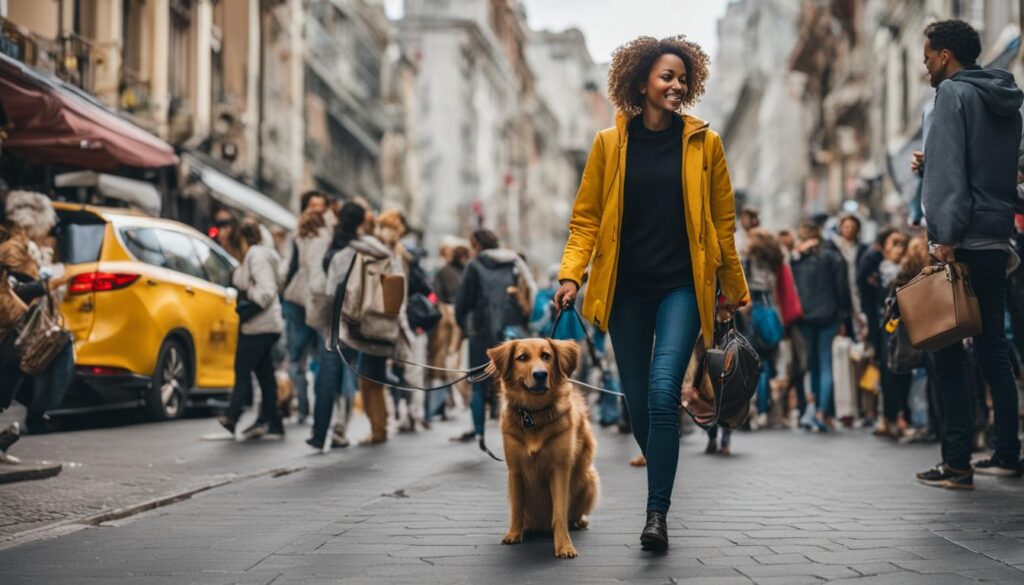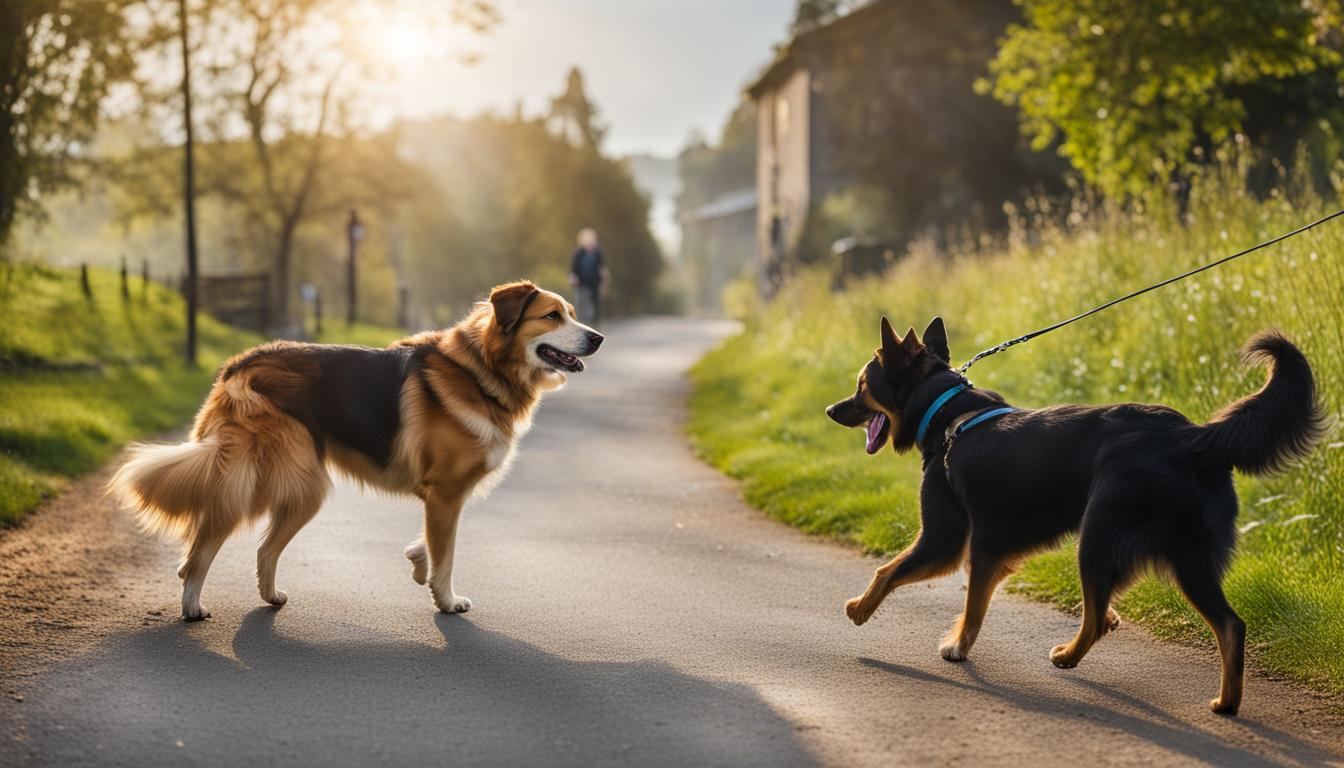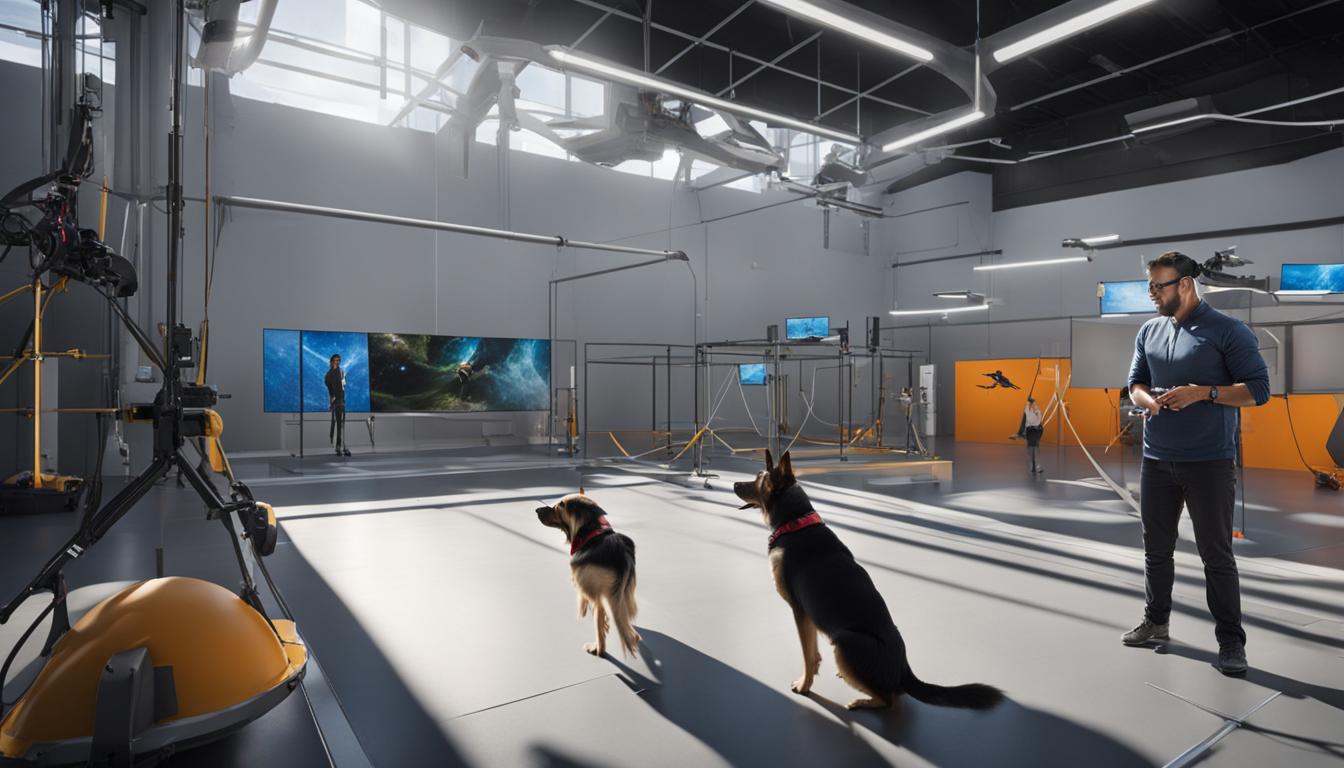Welcome to our comprehensive guide on training dogs for different environments. Whether you live in a bustling city or a tranquil countryside, it’s essential to understand the unique training techniques and considerations that can help your furry friend thrive in their surroundings. In this article, we’ll explore the challenges and tips for training dogs in urban and rural environments, ensuring they become well-adjusted and confident companions.
Key Takeaways:
- Training methods differ for urban and rural dogs due to the varying stimuli and challenges they face.
- Urban dogs require socialization, adaptability to city noises, and training cues for navigating crowded environments.
- Rural dogs benefit from exposure to people, dogs, and road noise to prevent territorial and reactive behavior.
- Establishing a strong bond with your dog and maintaining focus during walks are crucial in both environments.
- Desensitizing dogs to urban noises and addressing specific environmental challenges are essential for urban training.
Challenges of Training Dogs for Urban Living
Training dogs for urban living presents unique challenges that require careful consideration and adaptation. Urban environments are filled with high levels of stimulation, distractions, and traffic, which can make training more difficult. To help your dog thrive in the city, it is essential to establish a strong bond through regular walks and quality time together.
Walking together not only provides exercise but also deepens the bond and establishes trust between you and your furry friend. Consider incorporating a “smell walk” into your routine, allowing your dog to explore their environment without a specific agenda or route. This freedom to follow their nose can provide mental stimulation and help them adjust to the sights and sounds of the city.
Each dog breed has its own unique traits and challenges, so it’s important to tailor your training approach accordingly. Some breeds may require more socialization and exposure to different people, dogs, and noises to become comfortable in urban settings. Understanding and accommodating these specific needs will help your dog adapt and thrive in their urban environment.
To summarize, training dogs for urban living requires establishing a strong bond, incorporating “smell walks,” and adapting training techniques to suit each dog’s specific needs. By addressing these challenges head-on and providing the necessary support, you can help your dog navigate the urban environment with confidence and ease.

Table: Urban Training Challenges
| Challenge | Solution |
|---|---|
| High levels of stimulation | Establish a strong bond through regular walks and quality time together. |
| Distractions | Incorporate “smell walks” into your routine to provide mental stimulation and help your dog adjust to the city environment. |
| Traffic | Teach your dog to navigate busy streets safely by utilizing proper leash training and reinforcing commands. |
| Breed-specific challenges | Understand your dog’s breed traits and tailor your training approach to accommodate their unique needs. |
Socialization and Training Tips for Urban Dogs
Training urban dogs requires a unique approach due to the specific challenges they face in city environments. To help your urban dog navigate the bustling streets and sidewalks, it is crucial to focus on key training cues and socialization techniques.
Training Cues for Urban Dogs
When training your urban dog, it’s essential to focus on important cues that will help them navigate through busy streets and create personal space. Some key cues to prioritize include:
- Name/Attention: Teach your dog to respond when you call their name, focusing their attention on you amidst distractions.
- Leave It: Train your dog to ignore tempting objects or food on the ground, preventing them from picking up harmful items.
- Wait: Teach your dog to wait patiently at curbsides and intersections, ensuring their safety when crossing busy roads.
- Recall: Train your dog to come back to you on command, allowing you to maintain control over them in potentially hazardous situations.
- Paw/Shake: Teach your dog to offer their paw for greeting, promoting friendly interactions with other dogs and people.
- Moving Attention: Train your dog to focus their attention on you even while walking, preventing them from becoming overly fixated on distractions.
By reinforcing these cues consistently and positively, you can shape your urban dog’s behavior and ensure they can navigate the city environment with confidence.
“The key to successful urban dog training is to be attentive to your dog’s behavior and adapt your training methods accordingly. Pay attention to their body language and signs of stress, and use positive reinforcement to encourage desired behaviors. Every dog is unique, so be patient and adjust your training techniques to suit your dog’s individual needs.”
Socialization Techniques for Urban Dogs
Socialization is crucial for urban dogs to help them become comfortable in the city environment. Here are some tips to help you socialize your urban dog:
- Expose your dog to different people, places, and situations in the city. Take them on regular walks to parks, busy streets, and outdoor cafes.
- Arrange playdates with other well-behaved dogs to help your dog develop positive social interactions.
- Introduce your dog to various sounds commonly heard in the city, such as sirens, construction noises, and traffic sounds. You can use recordings or play them in the background during playtime.
- Consider enrolling your urban dog in obedience classes or hiring a professional trainer to provide guidance and support.
By gradually exposing your urban dog to different stimuli and providing positive experiences, you can help them become confident and well-adjusted city dwellers.
Adapting to Environmental Changes in Training
City dogs face unique environmental challenges that require adaptation in training methods. Unlike their rural counterparts, urban dogs need to navigate crowded sidewalks, encounter various distractions, and cope with high levels of stimulation. It is crucial to consider these factors and tailor your training approach to suit their specific needs.
Be patient and understanding as your urban dog adjusts to the city environment. Use positive reinforcement to reward desired behaviors and provide consistency in your training routine. Remember to stay attentive to your dog’s needs and adapt your training techniques accordingly.

With the right training and socialization techniques, your urban dog can thrive in the bustling city landscape, becoming a well-adjusted companion and enjoying the adventures of urban living.
The Importance of Attention and Interaction in Urban Dog Training
When it comes to training dogs in urban environments, one key factor that cannot be overlooked is the importance of attention and interaction. In bustling city streets and crowded sidewalks, it’s common for dog owners to become distracted by the hustle and bustle around them. However, maintaining focus on your dog is crucial for their safety and well-being.
Training your dog to pay attention to you and respond to cues effectively is essential for their success in urban living. Regular training sessions that incorporate treats or toys as rewards can help reinforce desired behaviors and strengthen the bond between you and your furry companion. By minimizing distractions and creating opportunities for focused interaction, you can help your dog navigate the challenges of city life with confidence.
One effective training technique in urban environments is to incorporate “moving attention” commands. This involves teaching your dog to maintain focus on you while you both walk or jog around the city. By practicing these commands, you can ensure that your dog remains attentive to you and less likely to be swayed by external stimuli.
The Benefits of Attention and Interaction
Providing attention and interaction to your urban dog has numerous benefits. Firstly, it helps strengthen the bond between you and your pet, fostering a sense of trust and security. This bond is especially important in busy city environments where potential dangers and distractions are common.
Secondly, consistent attention and interaction training can lead to better obedience and recall skills. When your dog is attentive to you, they are more likely to respond to commands promptly and reliably. This can make navigating crowded streets, crossing intersections, and avoiding potential hazards much safer for both you and your dog.
Lastly, attention and interaction training promotes positive behaviors and helps prevent behavioral issues commonly seen in urban dogs, such as excessive barking, aggression, and leash pulling. When your dog is engaged with you and focused on their training, they are less likely to exhibit these undesirable behaviors.
Building a Strong Foundation
Training your dog to pay attention and interact with you in urban environments requires consistency, patience, and repetition. Start with short training sessions in low-distraction areas, gradually increasing the difficulty as your dog becomes more comfortable and focused.
By providing attention and interaction during training, you’re setting the stage for a well-behaved and well-adjusted urban dog. With consistent training and positive reinforcement, your furry friend will thrive in their urban environment, and you’ll have a strong bond that can withstand the bustling city life.
| Benefits of Attention and Interaction Training: |
|---|
| Strengthens the bond between you and your dog |
| Improves obedience and recall skills |
| Prevents behavioral issues |
Environmental Considerations for Urban Dogs
Living in an urban environment can be quite challenging for dogs, as they are exposed to various noises and stimuli that are not commonly found in rural areas. In order to prepare dogs for urban noise, it is important to gradually desensitize them to these sounds. You can start by playing recorded noises from the city, such as sirens or construction, at a low volume and gradually increase the volume over time. Reward your dog for remaining calm during these sessions, and gradually expose them to the actual noises in the city.
In addition to noise, urban dogs also face unique challenges such as crowded sidewalks, busy intersections, and encountering trash on the streets. Training should focus on teaching dogs to leave trash alone, wait at intersections, and navigate through crowded areas safely. This can be achieved through positive reinforcement and consistent training sessions. By addressing these environmental considerations, urban dogs can feel more comfortable and confident in their surroundings.
“Training urban dogs to navigate through the city environment requires careful attention to their specific needs and challenges. By gradually desensitizing them to urban noise and teaching them how to navigate through crowded areas, owners can help their dogs thrive in an urban setting.”
The Importance of Addressing Stimulation in Urban Training
One of the key aspects of training urban dogs is addressing the high level of stimulation they experience in the city. This can include not only noise, but also visual stimuli such as cars, bicycles, and other people and dogs. One effective way to address stimulation is through controlled exposure. Slowly introduce your dog to different environments and gradually increase the level of stimulation. This can help your dog become more comfortable and less reactive in a variety of situations.
Another important aspect of urban training is teaching dogs to focus and pay attention to their owners despite distractions. This can be achieved through exercises that reinforce attention cues, such as name/attention commands and “moving attention” commands. By consistently practicing these exercises, you can help your dog maintain focus even in the midst of busy city life.
| Environmental Considerations for Urban Dogs | Benefits of Addressing Stimulation |
|---|---|
| Gradually desensitize dogs to urban noise | Helps dogs become more comfortable and less reactive in the city |
| Teach dogs to navigate through crowded areas | Promotes safety and confidence in urban environments |
| Controlled exposure to visual stimuli | Helps dogs adapt to various urban distractions |
| Reinforce attention cues and focus | Improves dogs’ ability to maintain focus amidst city distractions |

Conclusion
Congratulations on reaching the end! Now that you understand the importance of environmental adaptation in dog training, you’re ready to tackle the challenges of different environments. Whether you’re training your furry friend in the hustle and bustle of the city or the tranquility of the countryside, adapting to their surroundings is key.
Remember, training dogs for different environments requires a tailored approach. In urban areas, focus on establishing a strong bond with regular walks and quality time together. Teach them key cues like name/attention and leave it to navigate busy streets. And don’t forget to address the unique challenges of urban noise and crowded areas.
For rural environments, prioritize socialization and desensitization. Expose your pup to different people, dogs, and noises to prevent territorial and reactive behavior. Cross-foster them with farm animals to ensure they’re sociable. Be aware of the potential challenges of isolation and train accordingly.
By adapting to these environmental changes, you’ll help your furry friend become well-adjusted and confident in any situation. So grab your leash and embark on a training journey that fits your dog’s needs, whether they’re a city slicker or a country explorer!
FAQ
What are the challenges of training dogs for urban living?
Dogs living in urban environments face unique challenges such as high levels of stimulation, distractions, and traffic.
How can I socialize and train my urban dog?
Focus on key cues such as name/attention, leave it, wait, recall, paw/shake, and “moving attention” commands. Utilize positive reinforcement to condition desired behaviors.
How do I maintain focus on my dog while walking in the city?
Train your dog to pay attention to you and respond to cues effectively. Provide regular training sessions, use treats or toys as rewards, and minimize distractions.
How can I prepare my urban dog for city noise?
Gradually introduce recorded sounds and reward your dog for remaining calm. Desensitization plays a key role in helping them adjust to urban noise.
What are the differences between training dogs in urban and rural environments?
Urban dogs require more exposure to people, dogs, and noises, while rural dogs may need more training to prevent territorial and reactive behavior due to limited exposure.
How can I ensure my dog thrives in different environments?
Focus on socialization, training cues, and environmental considerations. Tailor your training approach to the specific needs and challenges of each environment.





